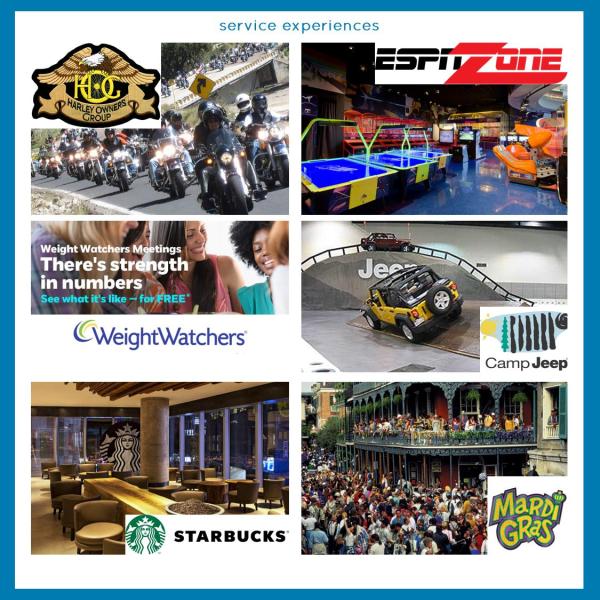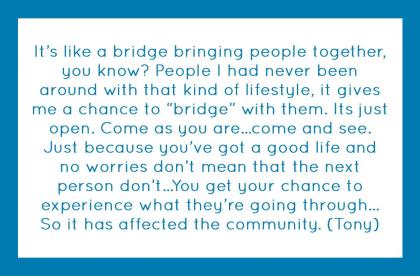Bridges for Transforming People and Cities: How extraordinary service communities cultivate human flourishing
Republished with permission. The original post was published on the Center for Services Leadership blog.
***
By Christopher P. Blocker and Andrés Barrios
Service experiences are so common we often forget when we are “experiencing” them. As a society, we spend quite a bit of time, money, and energy in service settings like healthcare, education, entertainment, food, government, and transportation, to name a few.
For better or worse, the vast majority of these experiences fade into the normal routine of our lives. Some make us quite mad, others happy for the moment, and many are apparently worthy of our social media posts.
Still, in the grand scheme of life, most services experiences are quite, well…ordinary. They satisfy our needs for the time being, and we move on.
However, sometimes a service experience can be truly extraordinary – meaning it changes us somehow for the better. We are different, even transformed, for having participated in them.
Extraordinary services are bridges
Beyond amazing customer service stories like ones at Zappos or USAA, extraordinary service experiences have the potential to improve our well-being. They act as a bridge from an undesirable “today” to a desirable “tomorrow.” And, increasingly, great companies and thought leaders are curious about what these experiences look like and how they work – especially for people who experience vulnerability from things like poverty, discrimination, or poor health.1
Some of the big questions being asked are …
- What distinguishes everyday, routine service experiences from profoundly meaningful ones that are undeniably transformative?
- How do service providers create “transformative” experiences that improve the well-being of people involved as well as broader society, like neighborhoods, or even cities?
Looking for transformation in all kinds of places
Marketing researchers have mined many kinds of service experiences (see examples in image) tolearn how they create value via entertainment, personal growth, achievement, community, and spectacular environments. These studies shed light on the trend of cultivating vibrant “brand communities.”

In our new study in the Journal of Service Research, we explore the idea of creating “transformative value” in service experiences. Here, the focus is on unpacking what social transformation can look like in a service context and how it fuels uplifting changes for people.
To answer some of the big questions mentioned above, we went looking in non-traditional places. We found one service experience that not only impacts the well-being of individuals involved but also has a transformative effect on a city.
Meet the Church Under the Bridge (CUB). For over twenty years, the CUB has met under an interstate highway (rain or shine) and directed its energies toward reducing the struggles of homelessness, poverty, and addiction while promoting social integration and human flourishing through physical, emotional, relational, and spiritual benefits. Importantly, the CUB has maintained a multi-cultural mission among people from all backgrounds and socio-economic strata. Other than its identity as a Christian church, the CUB strives for diversity and avoids distinctions created by ethnicity, income, age, or anything else that can divide people. Over the years, the CUB has served hundreds of homeless and non-homeless individuals from the region and has received overwhelming support from a broad array of businesses, non-profits, universities, news outlets, as well as federal, state, and city representatives and offices that span the spectrum of partisan values. Given the impressive evidence of micro and macro-level social transformation as well as the fact that attending a religious service is a common weekly activity, we chose the CUB as a case study.2
Unpacking the transformative value of a service experience
Using ethnographic analysis, we analyzed the CUB experience to uncover aspects of  “transformative value” in its service design and practices. Throughout our extended engagement and observation, participants living in a homeless situation shared stories of breaking free from destructive views of themselves, regaining dignity, absorbing new perspectives and skills, and being “encouraged and uplifted mentally, physically, and spiritually.” People from higher socio-economic backgrounds told us how their cold assumptions had unraveled over time and were replaced with “deep concern,” “joy,” and “seeing themselves and others in a whole new way.” Beyond social transformation for individuals involved
“transformative value” in its service design and practices. Throughout our extended engagement and observation, participants living in a homeless situation shared stories of breaking free from destructive views of themselves, regaining dignity, absorbing new perspectives and skills, and being “encouraged and uplifted mentally, physically, and spiritually.” People from higher socio-economic backgrounds told us how their cold assumptions had unraveled over time and were replaced with “deep concern,” “joy,” and “seeing themselves and others in a whole new way.” Beyond social transformation for individuals involved  at the CUB, our extended analysis with non-participating community members (e.g., local business, police force, mayor office) and archival review of public newspaper articles revealed ways that services can also create transformative value at a city level. In particular, public consensus analysis revealed that the CUB, over twenty years, has truly raised the “town’s social conscience,” transformed the “face” of a “homeless person” and stimulated widespread and sustained social action.
at the CUB, our extended analysis with non-participating community members (e.g., local business, police force, mayor office) and archival review of public newspaper articles revealed ways that services can also create transformative value at a city level. In particular, public consensus analysis revealed that the CUB, over twenty years, has truly raised the “town’s social conscience,” transformed the “face” of a “homeless person” and stimulated widespread and sustained social action.
The contours of transformative service design and practice
As we continued our analysis, several aspects of service design and practice at the CUB came into view. First, “holistic” value propositions engage the whole person, that is, mind, body, spirit, and relationships. Furthermore, the physical environment (the “servicescape”) creates an atmosphere where people from all backgrounds can break free from their normal social positions and see themselves in new and creative ways. Additionally, service practices facilitate “boundary-crossing” and the co-creation of a community that freely shares resources and perspectives.

Finally, we identified four dimensions that differentiate routine from transformative service experiences.
First, transformative service experiences prompt critical reflection (where am I in life? what is my story?) and inspire people into projective modes of thought and action (where do I want to go? how do I get there?). Second, this process of reflection and imagination fuels “global meanings” (this has changed me) that transcend the day-to-day situational meanings arising in routine service experiences. Third, these experiences influence real, observable change that promotes well-being. People make new choices, invest in new things, and build new capabilities. Finally, there is a clear “virtuous trajectory” evident in people (and cities). Although seldom linear, positive changes are layered on top of each other, and as in the butterfly metaphor, transformations occur and it is hard to imagine going backwards.
In sum, we find that extraordinary service communities design and co-create transformative value that can act as a bridge for helping individuals and even cities flourish.
The article The Transformative Value of a Service Experience, featured in the post, was co-authored by Christopher P. Blocker (Colorado State University, Fort Collins, CO, USA) and Andrés Barrios (Universidad de los Andes, Bogotá, Colombia). It is one of the 3 finalists for the 2015 Transformative Service Research Best Paper Award, sponsored by the Center for Services Leadership. The article is available on the Journal of Service Research website.
_____________________________________________________

![]()
![]()
![]() Dr. Christopher P. Blocker is an Assistant Professor at Colorado State University. His research focuses on understanding value creationwithin marketplace relationships. In addition to business and consumer relationships, Chris’ research explores value creation in contexts of global and domestic poverty, subsistence marketplaces, and social enterprise. Articles he has written have appeared in Journal of Consumer Research, Journal of the Academy of Marketing Science, Journal of Service Research, Journal of Public Policy & Marketing, among others, and he serves on the advisory board for Transformative Consumer Research.
Dr. Christopher P. Blocker is an Assistant Professor at Colorado State University. His research focuses on understanding value creationwithin marketplace relationships. In addition to business and consumer relationships, Chris’ research explores value creation in contexts of global and domestic poverty, subsistence marketplaces, and social enterprise. Articles he has written have appeared in Journal of Consumer Research, Journal of the Academy of Marketing Science, Journal of Service Research, Journal of Public Policy & Marketing, among others, and he serves on the advisory board for Transformative Consumer Research.

Dr. Andrés Barrios is Assistant Professor of ![]()
![]() Marketing at Universidad de Los Andes – Bogotá, Colombia. His research focuses on marketing and consumer behavior in contexts of poverty. He has developed studies about poverty from different research perspectives such Transformative Consumer Research, Consumer Culture Theory, and Subsistence Marketplaces. Andrés’ work has been published in the Journal of Business Research, Journal of Public Policy & Marketing, Research in Consumer Behavior, Advances in Consumer Research, and the Transformative Consumer Research 2012 Book.
Marketing at Universidad de Los Andes – Bogotá, Colombia. His research focuses on marketing and consumer behavior in contexts of poverty. He has developed studies about poverty from different research perspectives such Transformative Consumer Research, Consumer Culture Theory, and Subsistence Marketplaces. Andrés’ work has been published in the Journal of Business Research, Journal of Public Policy & Marketing, Research in Consumer Behavior, Advances in Consumer Research, and the Transformative Consumer Research 2012 Book.
__________________
- Understanding how services improve well-being through “transformative service” was recently identified as a top priority by 19 different service center networks around the world. Also, the idea of companies creating value that leads to greater well-being for employees, customers, and society continues to be a pressing topic (https://hbr.org/2011/01/the-big-idea-creating-shared-value/ar/pr)
- There are over 300,000 religious service organizations in North America alone, and increasingly these organizations integrate aspects related to health, recreation, leisure, and personal interest, which influences weekly engagement (Lindner 2012). At the same time, there is often dialogue around understanding one’s past, present, and future which interfaces with identity and existential beliefs. Thus, this kind of service offers an opportunity to study both habitual and transformative experience.
























































































